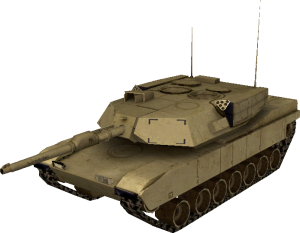GDIS - Bridge Live & Virtual Worlds in a Low-Cost Commercial Gaming Engine
 GDIS (Game Distributed Interactive Simulation) has been developed for the US Army as an integrated system for embedded training of soldiers with immersive virtual missions. Research for this product focuses on architecture, training metrics, and integration with low cost commercial gaming engine technology for use in distributed immersive applications. The product goals are to provide the Army with a man portable system which allows the soldier to train and perform after action review (AAR) on the same equipment they use in the virtual exercise. This equipment can include anything from a standard laptop computer to a man-worn immersive system.
GDIS (Game Distributed Interactive Simulation) has been developed for the US Army as an integrated system for embedded training of soldiers with immersive virtual missions. Research for this product focuses on architecture, training metrics, and integration with low cost commercial gaming engine technology for use in distributed immersive applications. The product goals are to provide the Army with a man portable system which allows the soldier to train and perform after action review (AAR) on the same equipment they use in the virtual exercise. This equipment can include anything from a standard laptop computer to a man-worn immersive system.
GDIS also includes extensions for integration with live unit data capture systems which allow virtual participants to interact with live units in the field or at distributed training facilities and MOUT sites. RNI supports the McKenna Soldier Battlelab in Ft. Benning Georgia with live data capture units called CommServers.
The use of commercial gaming technologies provides the soldier with a known interface (most recruits will have played video games) along with mature high-fidelity 3D rendering that is optimized for multiplayer network applications. This provides the Army with faster training, reduced negative training, and a common framework for force integration in virtual and live exercises. It also significantly shortens the development cycle of immersive rendering systems typically dominated by custom engines.
Summary
 GDIS is fully compliant with existing message protocols used in Army training and simulation activities. GDIS allows for virtual players (and live units in VR or other immersive systems) to interact collaboratively on missions and exercises. The Game DIS (GDIS) system provides both a DIS/HLA interface and an internet gateway and set of adapters for integration with event or entity based simulation or network. On the rendering side, GDIS has adapters, or has explored adaption, for (a) HalfLife2 Source – ValVe, (b) GameBryo – Emergent, (c) CryEngine3 – Crytek, (d) VBS2 – Bohemia, (e) Trinigy, (f) Unreal3, (g) Unity 3D, (h) EDGE/BIGWORLD.
GDIS is fully compliant with existing message protocols used in Army training and simulation activities. GDIS allows for virtual players (and live units in VR or other immersive systems) to interact collaboratively on missions and exercises. The Game DIS (GDIS) system provides both a DIS/HLA interface and an internet gateway and set of adapters for integration with event or entity based simulation or network. On the rendering side, GDIS has adapters, or has explored adaption, for (a) HalfLife2 Source – ValVe, (b) GameBryo – Emergent, (c) CryEngine3 – Crytek, (d) VBS2 – Bohemia, (e) Trinigy, (f) Unreal3, (g) Unity 3D, (h) EDGE/BIGWORLD.
RNI researchers are currently in a number of research efforts at Ft. Benning, ARI, Northrop Grumman, Aptima, and RDECOM using the GDIS system. The research relates to a wide variety of related areas such as:
- game based instructional training (GAMBIT),
- information impact assessments using unmanned robotics systems,
- multimodal interfaces for embedded simulation and training,
- immersive/desktop training interface evaluation,
- tactical combat casualty care (TC3) training,
- closed combat tactical training (CCTT) for dismounted soldier
- real-time motion capture and intent recognition systems
- remote sensor and equipment virtualization
- cultural authoring and advanced scenario design
- mobile apps and learning transfer assessments
The system has been successfully demonstrated (many times) with over 50 players in Advanced Technology Objective (ATO) activities and distributed training networks. GDIS SimBridge has been used with many existing DIS/HLA tools including VRLink, ACE, OTBSAF, DIVAARS, TeamMate, VirtualWarrior, and C2MINCs to just name a few. Recent activities have demonstrated integration with RNI’s real-time motion capture and intent recognition system known as the Multimodal Interfaces for Simulation and Training (MMIST) concept.
 The GDIS software allows the user to participate in many ways during a virtual / live exercise. The level of participation can range from administrator to user and provides support for both team and individual operations. Each training role (administrator, subject matter expert, spectator, trainee, commander, etc) has been successfully mapped into the 3D engine and heads-up-display (HUD). Distributed tools are also integrated to perform enhanced mission planning, rehearsal, and after action review. These distributed tools include data sharing, application sharing, white boards, picture-in-picture (PiP), and many other features standard in distributed work functions.
The GDIS software allows the user to participate in many ways during a virtual / live exercise. The level of participation can range from administrator to user and provides support for both team and individual operations. Each training role (administrator, subject matter expert, spectator, trainee, commander, etc) has been successfully mapped into the 3D engine and heads-up-display (HUD). Distributed tools are also integrated to perform enhanced mission planning, rehearsal, and after action review. These distributed tools include data sharing, application sharing, white boards, picture-in-picture (PiP), and many other features standard in distributed work functions.
The GDIS System has developed adapters for the following game engines:
- Half Life 2 (Source / Orangebox)
- GameBryo
- Unreal 3
- Cryengine 3
- Unity 3D
GDIS using Source/Half-Life 2 Engine Adapters
[nggallery id=8]
